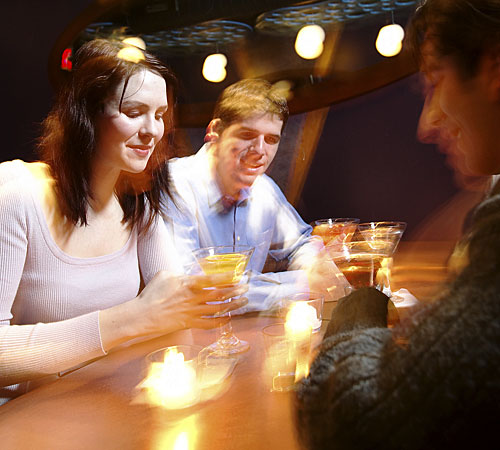Student drinking stories exceed reality

Photos.com
October 30, 2008
Last academic year, 925 students were cited for violating the student code’s provisions relating to alcohol.
Less quantifiable is the number of students who brag about their drinking behavior, whether or not it brings them University sanctions or other negative consequences.
Students and faculty members alike say the number of students who brag while telling their drinking stories may be a large one.
“There are always going to be students who do brag about their exploits around drinking,” said Betsy Peterson, who runs the Alcohol Culture Explored Interactive Theatre, or Ace-It, program for freshmen.
Peterson blames human nature as well as the campus drinking culture for students’ tendencies to speak about their alcohol-related behavior in a celebratory manner.
Get The Daily Illini in your inbox!
People also brag about their drinking experiences as a way to get attention, said Tarah Sublon, freshman in General Studies.
“You’ll hear ‘Oh, well I was with this girl and this girl last night,'” Sublon said. “Or you hear girls that are like ‘I lost my shoe at such and such a frat.'”
Sublon said she thinks these overstatements are the result of a competition students engage in to prove who had the best weekend.
“They think it makes them look cool,” she said. “But it doesn’t make you look good in any way.”
Turning drinking experiences, even negative ones, into stories to brag about may also stem from a desire of college-aged males to prove their masculinity, said Dr. Jim Ellis, chair of emergency medicine at Provena Covenant Hospital. Ellis said Provena sees about three to eight patients for alcohol-related treatment on the average Thursday, Friday or Saturday night, and some of these patients take pride in the experience.
“Unfortunately, they’re very proud of it,” Ellis said. “Some people wake up here and they have an IV in and no clothes and they’re very embarrassed. But there’s a lot of machismo with getting that drunk. It’s a huge problem on campus.”
Between June 1 and Sept. 22, 25 students were transported to a hospital for alcohol incapacitation, said Amy Carmen-Peck, clinical director of the Alcohol and Other Drug Office.
People who have a problem with alcohol often minimize the negative consequences of their experiences because they are in denial, Carmen-Peck said. This is not just a trend; rationalizing and justifying the results of an alcohol problem is an expected symptom of dependence, she said.
The Alcohol and Other Drug Office and the Counseling Center offer alcohol education classes, individual assessment workshops, group therapy programs and longer-term treatment options to help students deal with alcohol problems.
“They all address denial in some form,” Carmen-Peck said. “It’s about gaining insight and finding a different way to talk about the consequences to take the humor out of it or take the denial out of it.”
Students can opt into these programs on their own, or as a result of a University sanction for violating the student code. Between June 1 and Sept 22, 97 students have been issued a reprimand and referred for an assessment because of a code violation, Carmen-Peck said.
Sanctions range from completing an online survey to participating in inpatient therapy. The online survey, called the Electronic Check-Up To Go, or e-CHUG, helps students realize the reality of their drinking behaviors, said Brian Farber, associate dean of students and executive director of the Senate Committee on Student Discipline. The survey provides students with personal information comparing them to national and University-specific norms of drinking behavior, said Douglas Van Sickle, e-CHUG project director and professor at San Diego State University.
The data used to compare each respondent to students at the University and colleges nationwide came from surveys completed in 2006 by the Core Institute at Southern Illinois University, an organization that researches and assesses alcohol and drug behaviors across the country, Van Sickle said.
The University began using the e-CHUG program in January 2007, Farber said. He believes the information presented in student results is accurate because the campus alcohol culture is resistant to change.
“It’s a good initial step to ask people to interface with it,” Farber said. “It helps with social norming because people assume that people drink more than they do.”
Misconceptions may be furthered by students’ desire to tailor the truth of their stories to what they believe is expected of them and their partying behavior, Sublon said.
“If I go out drinking, I’m not going to make up a story about it,” she said. “But I think (other students) tell you what they think you want to hear.”
Whatever steps the University takes to address binging and bragging about it, preaching abstinence from all alcohol intake is not the solution, said Matt Reed, junior in business, and a leader of Ace-It classes and other alcohol-education programs.
“We talk about harm reduction,” Reed said. “We know people are going to drink and it’s a personal decision.”
Reed also said discussing possible negative consequences helps college students realize the significance of their actions, but sometimes talking about consequences is not enough – experience is necessary to fully understand the downside of drinking.
“One of the things is people associate a good time with drinking. If one time they went overboard, they don’t think it will happen again,” Reed said. “And if they don’t get caught, the mentality lives on.”






